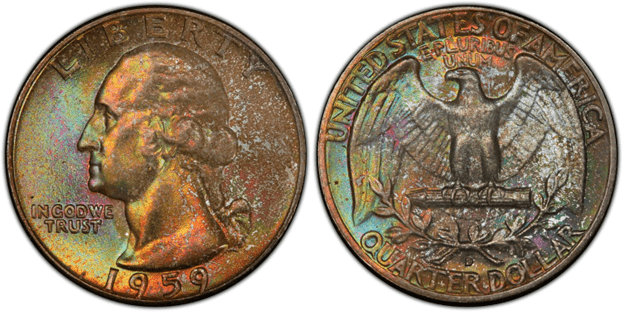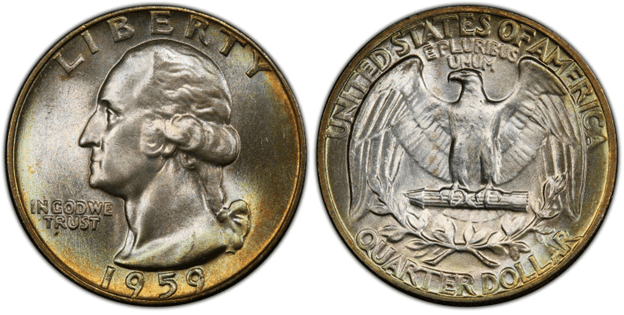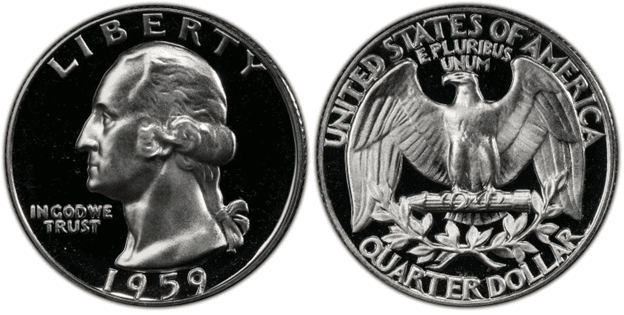The 1959 Washington quarter comprises 90% silver and 10% copper. It has a value of 25 cents, a mass of 6.30 grams, a diameter of 24.26 mm, a thickness of 1.75 mm, and a reeded edge.
Initially, the Washington quarter was made of 6.25 grams of 90% silver. This lasted until 1964 when the US Mint decided to switch to a base-metal composition, which in this case, copper and nickel.
The Washington quarter was first struck in 1932. John Flanagan originally designed the coin, and the quarter features the left profile of George Washington, the first president of the United States. Flanagan’s design would then be used up until 1998.

As mentioned, the obverse of the 1959 quarter includes the image of George Washington facing to the left. Above his head is the word “LIBERTY,” an American value deeply ingrained in their culture. Below is the year of minting, which in this case, 1959. Just under the chin of Washington is the American motto, “IN GOD WE TRUST.”
The reverse includes the American bald eagle, which represents the strength of the United States. Just above the head of the eagle reads, “E PLURIBUS UNUM,” which means out of many, one. On the top portion of the coin, you’ll find the words “UNITED STATES OF AMERICA.”
The eagle is perched on a bundle of arrows that represents the readiness of the US to go to war when needed. Under the arrows are branches of olive, which represent peace. Finally, the lowermost part of the coin reads, “QUARTER DOLLAR.”
1959 Washington Quarter Varieties
For the 1959 Washington quarter, there were three standard-struck varieties produced. These are the 1959 D, 1959 P with no mint mark, and the 1959 P proof Washington quarter.
Aside from that, some coins with errors also created a new variety.
Here are the 1959 Washington quarter varieties that you should know:
1959 D Washington Quarter
Year of minting: 1959
Mint Mark: D
Place of minting: Denver
Quantity produced: 62,054,232
Face Value: $0.25 (twenty-five cent)
Price: $0.25 to $18 (or more)
Mass: 6.30 grams
Edge: Reeded
Designer: John Flanagan
Composition: 90% silver and 10% copper
Diameter: 24.3 millimeters
Thickness: 1.75 millimeters

The 1959 D Washington quarter was struck in the Denver Mint. This variety is the most abundant, with more than 62 million struck quarter coins. The price starts at around $0.25 to $18.
1959 P Washington Quarter
Year of minting: 1959
Mint Mark: No mint mark
Place of minting: Philadelphia
Quantity produced: 24,384,000
Face Value: $0.25 (twenty-five cent)
Price: $0.25 to $22 (or more)
Mass: 6.30 grams
Edge: Reeded
Designer: John Flanagan
Composition: 90% silver and 10% copper
Diameter: 24.3 millimeters
Thickness: 1.75 millimeters

The 1959-P quarter coins were made in the Philadelphia Mint. At the end of 1959, 24,384,000 P Washington quarter coins were produced, far less than what the Denver Mint produced.
The price tag of 1959-P quarter coins may start from $0.25 and reach up to $22. If your 1959-P quarter receives a good grade, it can have a higher value.
1959 P Proof Washington Quarter
Year of minting: 1959
Mint Mark: No mint mark
Place of minting: Philadelphia
Quantity produced: 1,149,291
Face Value: $0.25 (twenty-five cent)
Price: $0.25 to $60 (or more)
Mass: 6.30 grams
Edge: Reeded
Designer: John Flanagan
Composition: 90% silver and 10% copper
Diameter: 24.3 millimeters
Thickness: 1.75 millimeters

One of the reasons the Philadelphia Mint didn’t produce as many coins as the Denver Mint was that the Philadelphia Mint produced both business strike and proof strike coins.
In 1959, the Philadelphia Mint produced more than one million quarter-proof coins. Proof coins are especially different from standard coins. For one, proof coins are shinier and have more details. The Mint would sometimes strike the coin twice to bring out more detailed engraved elements. Not only that, but proof coins are manually wiped and cleaned to improve their luster.
Moreover, proof coins were made for collectors and not for general use. Price may range from $0.25 to $60.
List Of 1959 Washington Quarter Errors
With more than 87 million 1959 Washington quarters produced, it was just a matter of time before a coin would receive an error. The 1959 quarter isn’t an exemption. Like other series, it has received a fair share of errors.
One error that you might find is the struck-through error. This happened when the die struck the planchet while there was a foreign material between them. The foreign material can be metal scraps, dust, and even grease.
Here’s what a struck-through error looks like:

There are times as well when the mint mark is struck twice. This was especially an issue with the coins produced in the Denver Mint. Remember, the Philadelphia Mint traditionally don’t add their P mint mark.
When a mint mark is punched twice, it’s called the repunched mint (RPM) error. Here’s an example:

Now, other errors could have affected the 1959 quarter minting process. These are the following:
- Off-strike error happens when there’s a misalignment between the die and the planchet. The die struck the planchet at the wrong angle.
- Broadstrike error happens when the planchet isn’t properly held in its place. When the die struck the coin, the planchet plattened like a pancake.
- Planchet error – during the cutting of the planchet, there could be some errors that could happen. For one, the planchet might have cut too thick or too thin. The planchet can be clipped or folded.
- Doubled die strike occurs when the die strikes the coin twice, doubling the engraved elements.
Although error coins are something the US Mint doesn’t want to happen, they are valuable in the eyes of collectors. Error coins are interesting and fun to collect.
How Much Is the 1959 Washington Quarter Worth Today?
The 1959 Washington quarter is worth $0.25, as its face value suggests. Its melt value is higher since this coin is made of silver. The melt value is $4.0637. This value can increase or decrease depending on the market value of silver.
The melt value and face value of the 1959 quarter might not be that big, but you will be surprised that there are 1959 Washington 25 cents to be worth a lot of money.
Just to give you an overview, you may want to check this 1959 Washington Quarter values chart:
| Coin | Condition | Grade | Mintage | Value |
| 1959 D Washington Quarter | Circulated/mint | Not graded | 62,054,232 | $0.25 to $18 |
| 1959 D Washington Quarter | Uncirculated/mint | MS-65 | 62,054,232 | $12 to $423 |
| 1959 D Washington Quarter | Uncirculated/mint | MS-66 | 62,054,232 | $23 to $600 |
| 1959 D Washington Quarter | Uncirculated/mint | MS-67 | 62,054,232 | $1,200 to $9,600 |
| 1959 P Washington Quarter | Circulated/mint | Not graded | 24,384,000 | $0.25 to $22 |
| 1959 P Washington Quarter | Uncirculated/mint | MS-65 | 24,384,000 | $11 to $1,140 |
| 1959 P Washington Quarter | Uncirculated/mint | MS-66 | 24,384,000 | $20 to $188 |
| 1959 P Washington Quarter | Uncirculated/mint | MS-67 | 24,384,000 | $384 to $6,000 |
| 1959 P Proof Washington Quarter | Uncirculated/mint | Not graded | 1,149,291 | $0.25 to $60 |
| 1959 P Proof Washington Quarter | Uncirculated/mint | MS-67 | 1,149,291 | $10 to $81 |
| 1959 P Proof Washington Quarter | Uncirculated/mint | MS-68 | 1,149,291 | $27 to $165 |
| 1959 P Proof Washington Quarter | Uncirculated/mint | MS-69 | 1,149,291 | $51 to $161 |
As you can see, 1959 quarters are really valuable. To further help you understand their value, notice the auction records of the 1959 quarters.
The 1959 P quarter coin with an MS67 grade was sold for $17,250 in April 2012 by Heritage Auction. The 1959 D MS67 quarter has an auction record of $14,950. Finally, the 1959 proof, which has a grade of PR69DCAM, has an auction record of $11,750.
How Does The Grading System Work?
The Sheldon Scale is used by numismatists to provide a numerical value to coins. The Sheldon Scale goes from poor (P-1) to perfect mint state (P-1) (MS-70). Coins were originally evaluated using words to reflect their condition (Good, Fair, Excellent, Etc.). Unfortunately, coin collectors and dealers had different ideas about what each of these terms represent.
Professional numismatists joined together in the 1970s and established CoinGrading standards. These numismatists now assign grades at key places on the seventy-point scale, using the most regularly utilized numeric points in conjunction with the original adjective grade. The following are the most common coin grades:
-
-
- (P-1) Poor – Indistinguishable and probably damaged; if used, must have a date and mintmark; otherwise, rather battered.
- (FR-2) Fair – Nearly smooth, but without the damage that a coin graded Poor often possesses. The coin must have enough detail to be identified.
- (G-4) Fair – Inscriptions have merged into the rims in some areas, and important elements have been mostly erased.
- (VG-8) Very Good- A little weathered, but all of the primary design elements are visible, albeit faintly. There is little if any, central detail left.
- (F-12) Good – The item is very worn, yet the wear is even, and the overall design details stand out clearly. Rims are almost completely isolated from the field.
- (VF-20) Very Fine – Moderately weathered, with some finer features still visible. The motto or all letters of LIBERTY are readable. Both sides of the coin have entire rims that are separated from the field.
- (EF-40) Extremely Fine – Gently used; all gadgets are visible, and the most important ones are bold. The finer details are bold and clear, however, light wear may be seen.
- (AU-50) Uncirculated – Slight evidence of wear on the coin’s design’s high points; may have contact marks; eye appeal should be adequate.
- (AU-58) Uncirculated Choice – Slight traces of wear, no severe contact marks, almost full mint shine, and great eye appeal.
- (MS-60) Mint State Basal – Strictly uncirculated; no indication of wear on the coin’s highest points, but an unsightly coin with reduced luster, visible contact marks, hairlines, and other flaws.
- (MS-63) Mint State Acceptable – Uncirculated, but with contact scratches and nicks, little reduced shine, but otherwise appealing appearance. The strike is weak to average.
- (MS-65) Mint State Choice – Uncirculated with great mint shine, very little contact blemishes, and exceptional eye appeal. The strike is unusually severe.
- (MS-68) Mint State Premium Quality – Uncirculated with superb luster, no obvious contact marks to the naked eye, and exceptional eye appeal. The strike is quick and appealing.
- (MS-69) Almost Perfect Mint State – Uncirculated with perfect brilliance, a sharp and appealing strike, and extremely good eye appeal. A near-perfect coin with minor imperfections in the planchet, strike, and contact markings (seen only under 8x magnification).
- (MS-70) Mint State Perfect – Under 8x magnification, there are no tiny imperfections discernible; the strike is crisp, and the coin is perfectly centered on a beautiful planchet. Rarely seen on a coin, this coin is bright and whole, with original luster and exceptional eye appeal.
-
Where To Buy Or Sell 1959 Washington Quarter?
The 1959 Washington quarter is available on the Internet. Some of the most popular websites where you can buy this coin are Amazon, Etsy, and eBay. Some websites, such as USA Coin Book and Coin Tracker, specialize in selling and buying coins.
Aside from the Internet, you can visit coin shops, coin collectors’ hubs, antique stores, and pawnshops. You might also be able to find 1959 quarters in auctions.
If you can, join clubs or groups of coin enthusiasts. The wider your network of contacts is, the more you’ll have enough information on where to buy or sell 1959 Washington quarters.
FAQs
Is there a rare 1959 quarter?
The 1959 quarter is rare in top grades. For example, 1959 quarters with a grade of at least MS 67 and PR 68 can be considered rare since only a few quarters receive this grade.
Is there a 1959 quarter worth $11000?
Yes, there is a 1959 quarter that is worth $11,000. One good example is the 1959-D 25C MS67 coin. It was sold for $14,950 by Heritage Auctions last April 2012.
How many grams of silver are in a 1959 quarter?
The 1959 quarter comes with 5.623 grams of 90% silver or 1808 troy oz silver.
